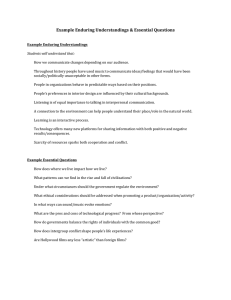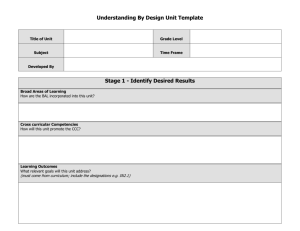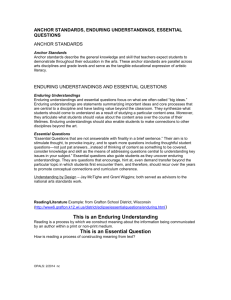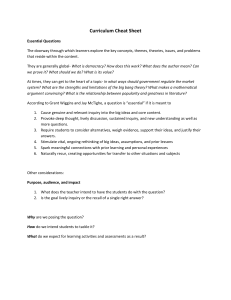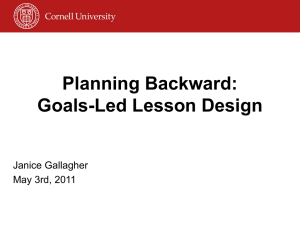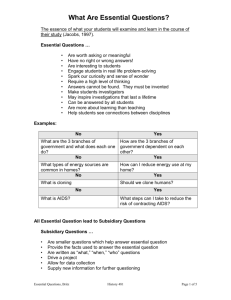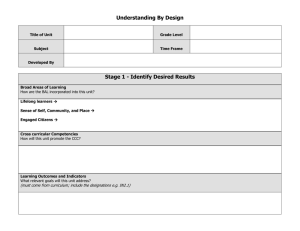Advanced Placement American History
advertisement
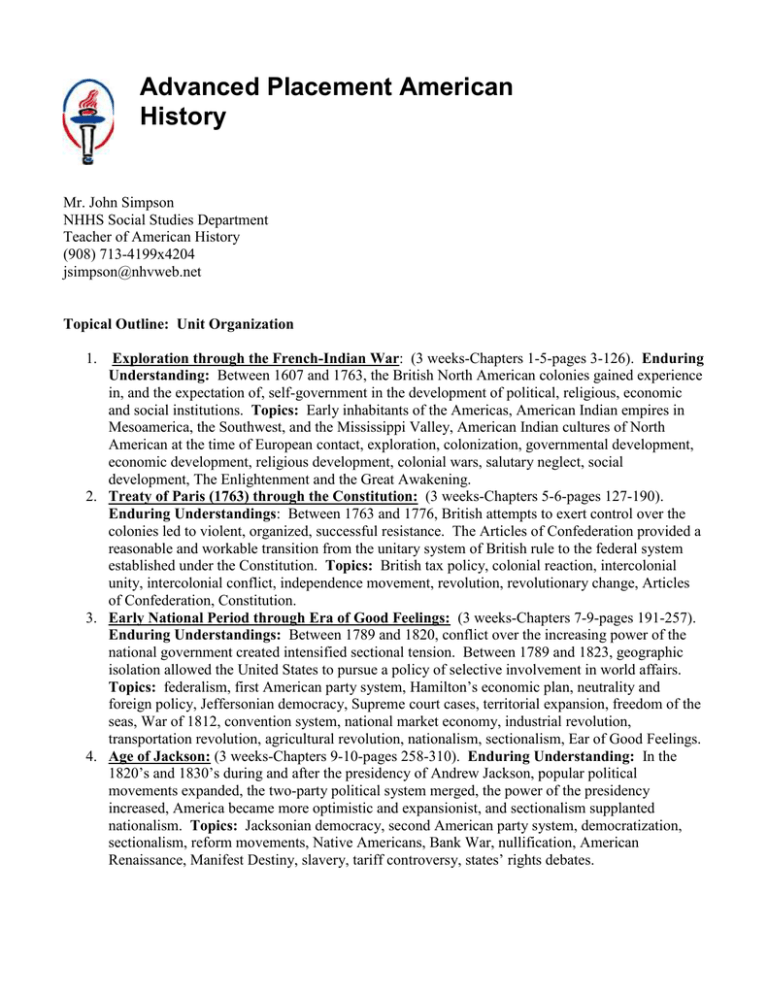
Advanced Placement American History Mr. John Simpson NHHS Social Studies Department Teacher of American History (908) 713-4199x4204 jsimpson@nhvweb.net Topical Outline: Unit Organization 1. Exploration through the French-Indian War: (3 weeks-Chapters 1-5-pages 3-126). Enduring Understanding: Between 1607 and 1763, the British North American colonies gained experience in, and the expectation of, self-government in the development of political, religious, economic and social institutions. Topics: Early inhabitants of the Americas, American Indian empires in Mesoamerica, the Southwest, and the Mississippi Valley, American Indian cultures of North American at the time of European contact, exploration, colonization, governmental development, economic development, religious development, colonial wars, salutary neglect, social development, The Enlightenment and the Great Awakening. 2. Treaty of Paris (1763) through the Constitution: (3 weeks-Chapters 5-6-pages 127-190). Enduring Understandings: Between 1763 and 1776, British attempts to exert control over the colonies led to violent, organized, successful resistance. The Articles of Confederation provided a reasonable and workable transition from the unitary system of British rule to the federal system established under the Constitution. Topics: British tax policy, colonial reaction, intercolonial unity, intercolonial conflict, independence movement, revolution, revolutionary change, Articles of Confederation, Constitution. 3. Early National Period through Era of Good Feelings: (3 weeks-Chapters 7-9-pages 191-257). Enduring Understandings: Between 1789 and 1820, conflict over the increasing power of the national government created intensified sectional tension. Between 1789 and 1823, geographic isolation allowed the United States to pursue a policy of selective involvement in world affairs. Topics: federalism, first American party system, Hamilton’s economic plan, neutrality and foreign policy, Jeffersonian democracy, Supreme court cases, territorial expansion, freedom of the seas, War of 1812, convention system, national market economy, industrial revolution, transportation revolution, agricultural revolution, nationalism, sectionalism, Ear of Good Feelings. 4. Age of Jackson: (3 weeks-Chapters 9-10-pages 258-310). Enduring Understanding: In the 1820’s and 1830’s during and after the presidency of Andrew Jackson, popular political movements expanded, the two-party political system merged, the power of the presidency increased, America became more optimistic and expansionist, and sectionalism supplanted nationalism. Topics: Jacksonian democracy, second American party system, democratization, sectionalism, reform movements, Native Americans, Bank War, nullification, American Renaissance, Manifest Destiny, slavery, tariff controversy, states’ rights debates. 5. Causes of the Civil War through Reconstruction 1840-1877: (3 weeks-Chapters 11-16-pages 311-500). Enduring Understandings: The Civil War caused by historic economic, social, and political sectional differences that crystallized around the slavery issue. The Civil War effectively determined the nature of the Union, the economic direction of the United States, and political control of the country. Topics: Sectionalism, abolition, expansion of slavery, apologists, Compromise of 1850, Kansas-Nebraska Act, third American party system, popular controversies over slavery, economic development, social development, Civil War ( social, economic, political consequences), amendments, Reconstruction (economic, political, social consequences), Compromise of 1877, politics of segregation. 6. Gilded Age through Populism-Post Civil War-1890’s: (3 weeks-Chapters 17-20-pages 501615). Enduring Understanding: The Gilded Age fostered the consolidation of business, the beginnings of governmental involvement in the economy, and the organization of disadvantaged economic and social classes. Topics: Grantism, corruption, politics, rise of big business, agrarian reform, labor movement, Native Americans, cattle frontier, mining frontier, agricultural frontier, immigration, urbanization, Social Gospel, Social Darwinism, changing function of government. 7. New Imperialism, Progressivism, and World War I: (4 weeks-Chapters 20-22-pages 616-694). Enduring Understandings: From 1890 to 1918, the United States became increasingly active and aggressive in world affairs. The Progressive movement partially succeeded in improving life for average Americans by curbing big business, making the government more responsive to the will of the people, and enacting social welfare legislation. Topics: New Imperialism, SpanishAmerican War, Big Stick policy (jingoism), internationalism, Progressive reform (political, social, economic), regulatory agencies, Square Deal, Old Guard (Conservative Republicans led by Speaker of the House “Uncle Joe Cannon) versus Insurgents (Progressive Republicans who sought to limit the power of the Speaker of the House), New Nationalism, New Freedom, Supreme Court and social welfare, World War I (economic, political, social consequences), the Committee on Public Information, Red Scare, Treaty of Versailles. 8. 1920’s through the New Deal: (4 weeks-Chapters 23-24-pages 696-762). Enduring Understandings: Disillusionment with the idealism that led the country into World War I drove Americans to fear change and difference and to retreat into a superficial shell of self-satisfaction. The Great Depression and New Deal resulted in an expectation of government intervention to maintain the economic stability of the nation. Topics: fear of change and difference, value conflicts, mass society, consumerism, technological development, foreign policy, social changes, arts and entertainment, economics “normalcy,” Great Depression, New Deal, relief, recovery, reform, public works projects, labor, political realignment, changing function of government, modernism. 9. World War II through 1960: (2 weeks-Chapters 25-27-pages 764-856). Enduring Understandings: Between World War II and 1960, the New Deal philosophy that the government was a legitimate agent of social welfare became firmly embedded in the American mind. The Cold War led the United States to pursue an ambivalent policy of confrontation, negotiation, and preparedness between 1945 and 1970. Topics: 1930s foreign policy, neutrality, World War II ( political, economic, social consequences), strategies and battles, postwar demobilization, Fair Deal, Red Scare, containment, Cold War, NSC 68, Korean War, modern Republicanism, massive retaliation, social changes, politics of the 1950’s, consumerism, baby boom. 10. 1960 through the Present: (2 weeks-Chapters 28-32-pages 858-1008). Enduring Understandings: Disillusionment with the increasingly violent protest of the 1960s and the social movements in their aftermath led to the rise of conservative ideology and political groups between 1968 and 1992. Following the breakup of the Soviet Union, America’s foreign policy groped for ways to promote world peace with minimal U.S. direct military involvement. Technological developments between 1950 and 2000 radically altered the economic, social, and moral fiber of the nation. Topics: Liberalism, civil rights, feminism, identity politics, political activism, foreign policy, Vietnam, youth culture, poverty, conservative resurgence, energy, Watergate, malaise, Reagan revolution ( foreign policy, economy, social issues), technology and affluence, post-Cold War foreign policy, Middle East, multiculturalism, welfare, Clinton scandals. Throughout the units the following United States History themes will be discussed and studied: 1. American Diversity 2. American Identity 3. Culture 4. Demographic Changes 5. Economic transformations 6. Environment 7. Globalization 8. Politics and Citizenship 9. Reform 10. Religion 11. Slavery and its legacies in North American 12. War and Diplomacy A brief explanation of each of these themes can be found in the United States History Course Description packet.
